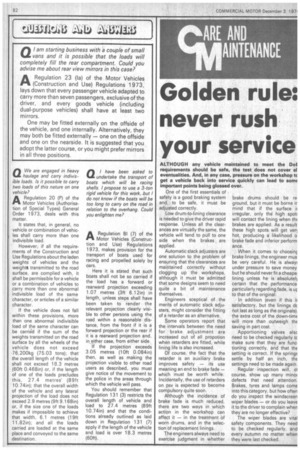Golden rule: never rush your service
Page 86

If you've noticed an error in this article please click here to report it so we can fix it.
ALTHOUGH any vehicle maintained to meet the DoE requirements should be safe, the test does not cover al eventualities. And, in any case, pressure on the workshop tc get a vehicle back into service quickly can lead to sonic important points being glossed over.
One of the first essentials of safety is a good braking system and, to be safe, it must be adjusted correctly.
Low drum-to-lining clearance is needed to give the driver rapid response. Unless all the clearances are virtually the same, the vehicle will tend to pull to one side when the brakes are applied.
Automatic slack adjusters are one solution to the problem of ensuring that the clearances are maintained correctly without clogging up the workshops, although it must be admitted that some designs seem to need quite a bit of maintenance themselves.
Engineers sceptical of the merits of automatic slack adjusters, might consider the fitting of a retarder as an alternative.
Some operators report that the intervals between the need for brake adjustment are increased out of all propotion when retarders are fitted, while lining life is also increased.
Of course, the fact that the retarder is an auxiliary brake improves safety — its use meaning an end to brake fade — which must be worth while. Incidentally, the use of retarders on psv is expected to become compulsory quite soon.
Although the incidence of brake fade is much reduced, there are two ways in which action in the workshop can affect it — in the treatment of worn drums, and in the selection of replacement linings.
The engineers always need to exercise judgment in whether brake drums should he re. ground, but it must be borne ir mind that if the surface irregular, only the high spot: will contact the lining when th( brakes are applied. As a result these high spots will get ver) hot, producing a likelihood o brake fade and inferior perform ance.
When it comes to choosinc brake linings, the engineer mus. be very careful. He is alwayr under pressure to save money but he should never fit a cheapei lining unless he is absolutel) certain that the performance particularly regarding fade, is Lir to that of the original.
In addition (even if this it satisfactory, but the linings dc not last as long as the originals), the extra cost of the down-time will more than outweigh the saving in part cost.
Apportioning valves alsc need to be checked regularly tc make sure that they are func. tioning correctly, and that the setting is correct. If the springs settle by half an inch, the settings need to be made again.
Regular inspection will, ol course, show up many minor defects that need attention. Brakes, tyres and lamps come into this category, but how often do you inspect the windscreen wiper blades — or do you leave it to the driver to complain when they are no longer effective?
The wiper blades are vital safety components. They need to be checked regularly, and every autumn no matter when they were last checked.






























































































































